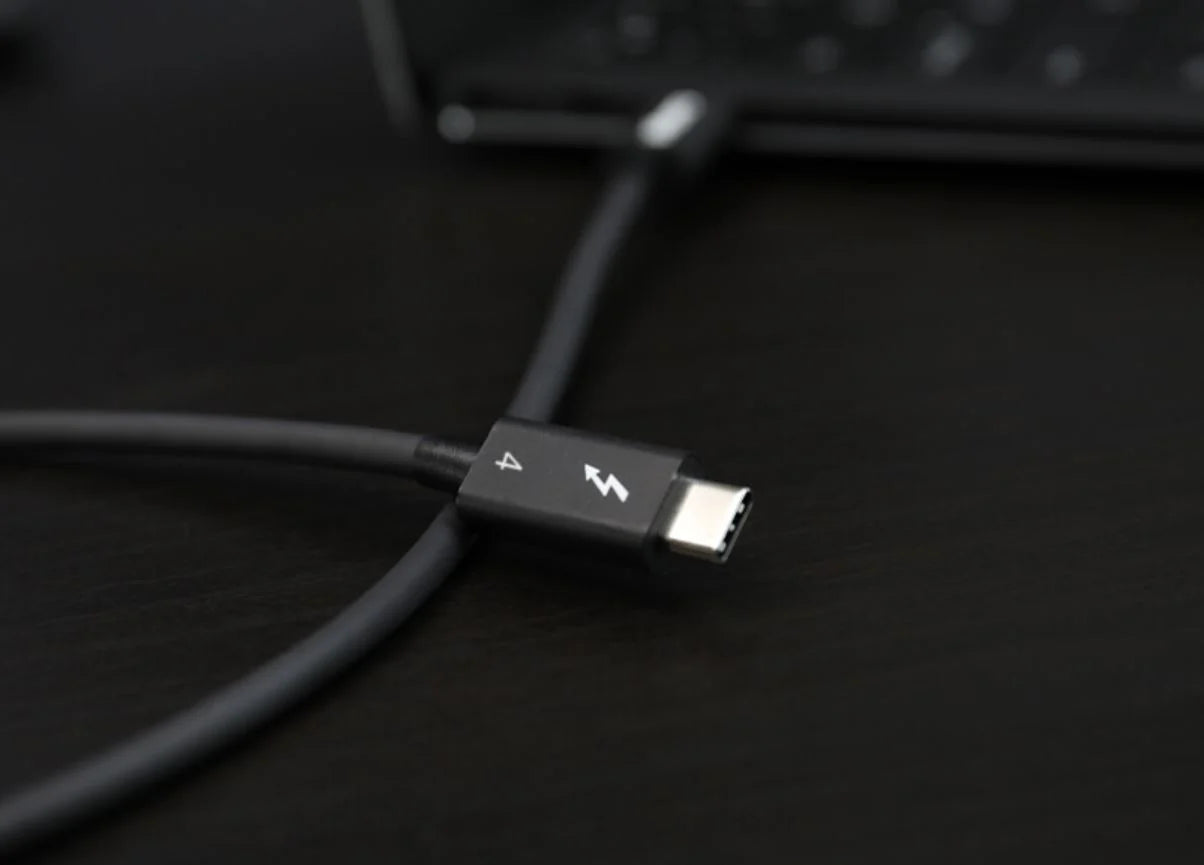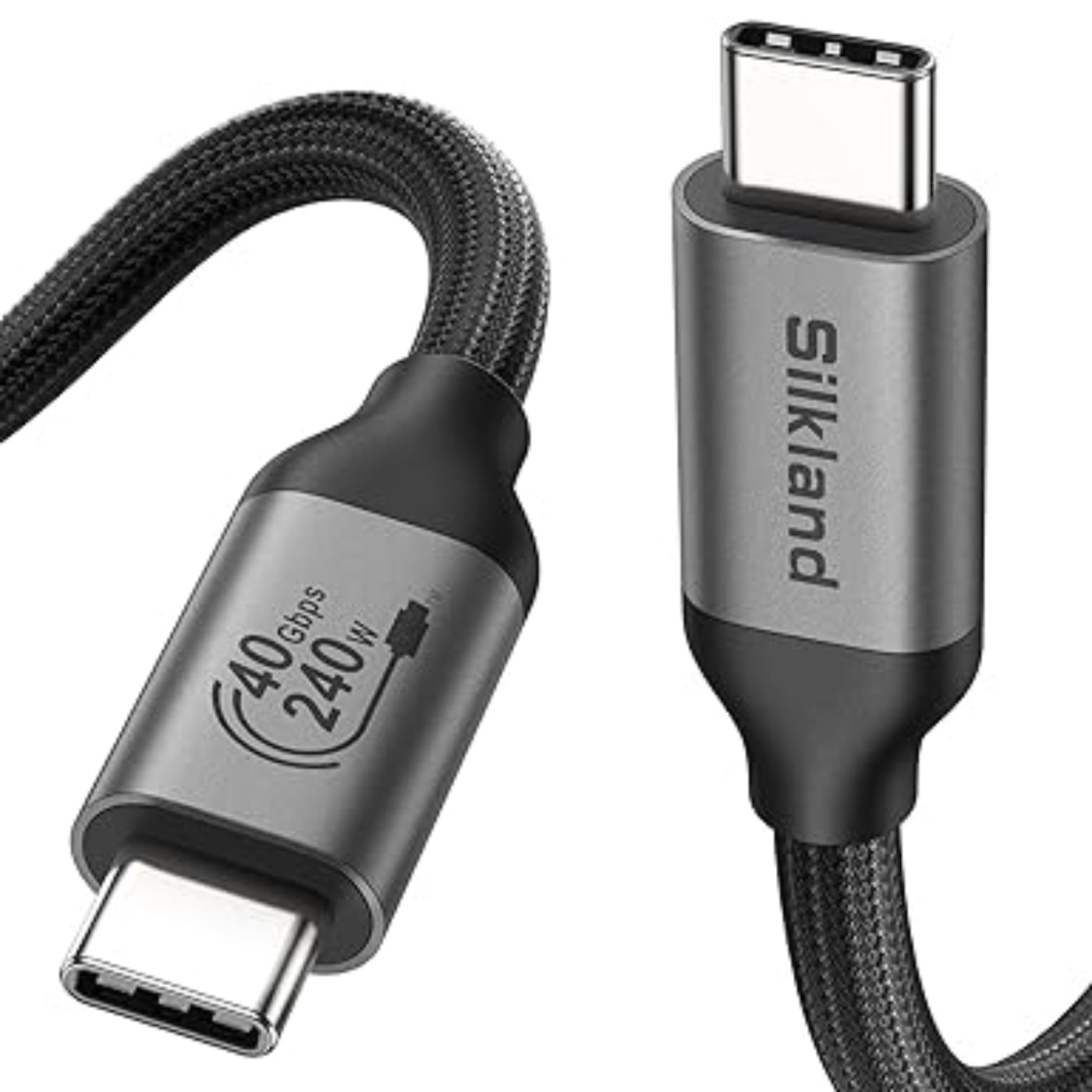At first glance, USB4 and Thunderbolt 4 look identical. They both use the same USB-C connector, and most users assume they work the same way. But is USB4 the same as Thunderbolt 4? Not quite. While they share some features—like high-speed data transfer, video output, and charging—there are important technical differences that could affect which one works best for your laptop, monitor, or external drive. If you're wondering about the real difference between USB4 and Thunderbolt 4, or whether Thunderbolt 4 is just a faster version of USB4, this guide will help you understand what matters, without the confusing jargon.

In this article:
Part 1: What is USB4?
USB4 is the latest major update to the USB standard, designed to make data transfer, video output, and device charging faster and more reliable. It builds on the USB-C connector we’ve seen in recent years, but adds performance and flexibility that older USB versions can’t match. If you’ve heard of USB 3.2 or even USB 3.0, USB4 takes things a big step forward—especially in speed and how it handles multiple tasks at once.
Unlike earlier USB generations, USB4 specs are based on the Thunderbolt 3 protocol. This means it can offer speeds of up to 40Gbps on supported devices and cables, matching what Thunderbolt can do in many cases. But here’s the catch: not every USB4 device will reach that maximum. The actual USB 4.0 speed can vary depending on the version—USB4 v1 or the newer USB4 v2—and on the manufacturer’s implementation.
A key strength of USB4 is that it can carry data, video, and power over a single cable. For example, you can connect a monitor, transfer files, and charge your laptop—all at the same time—without separate connections. It also supports backward compatibility with older USB standards, so your existing USB devices won’t become useless.
If you’re wondering is USB4 the same as Thunderbolt, the short answer is no—but the overlap is why many people get confused. USB4 offers Thunderbolt-like performance in certain setups, but the features you actually get depend on the specific device and cable you use.

Part 2: What is Thunderbolt 4?
Thunderbolt 4 is Intel’s latest high-speed connectivity standard, designed to deliver consistent 40Gbps bandwidth, robust video output, and rock-solid compatibility across devices. Like USB4, it uses the USB-C connector, but it follows stricter requirements—meaning every certified Thunderbolt 4 port and cable must meet the same high performance and feature set.
Whereas USB4 can vary in speed depending on device and cable, Thunderbolt 4 guarantees the maximum 40Gbps data transfer rate across all certified products. This makes it a favorite among professionals working with high-resolution video editing, 3D rendering, or ultra-fast external storage. It can also handle dual 4K monitors or a single 8K display, while supporting PCIe data speeds up to 32Gbps—ideal for external GPUs or ultra-fast NVMe SSD enclosures.
Another key advantage of Thunderbolt 4 is its stringent device compatibility. Any certified Thunderbolt 4 port must support:
- Full 40Gbps bandwidth on all ports.
- Dual 4K or single 8K video output.
- PCIe 32Gbps throughput for high-speed peripherals.
- Universal cable compatibility (up to 2 meters without losing speed).
- Power delivery up to 100W for charging laptops.
In practice, this means you don’t have to guess whether your device or cable can handle full performance—if it’s Thunderbolt 4-certified, you’re covered. While it’s technically built on the same underlying protocol as USB4, its guaranteed specs make it more predictable for high-performance workflows.
For anyone asking, “Is Thunderbolt the same as USB4?”—the answer is NO. While Thunderbolt 4 is compatible with USB4 devices and can share the same port, its minimum performance requirements set it apart. If you need absolute reliability for demanding setups, Thunderbolt 4 is the safer bet, even if it comes at a higher cost.

Part 3: USB4 vs. Thunderbolt 4 - Similarities and Differences
If you’ve ever looked at the ports on a modern laptop, you might have wondered: is USB4 the same as Thunderbolt 4? The short answer: no—but they are closely related. Both use the USB-C connector, both can handle high-speed data, video output, and power delivery, and both are part of the latest wave of universal connectivity standards. But the differences matter, especially if you care about maximum speed, display support, and guaranteed compatibility.
Core Similarities
Before diving into the differences, here’s what USB4 vs Thunderbolt 4 have in common:
- Connector Type: Both use the USB-C connector.
- Data + Video + Power: Both can transfer data, output video to monitors, and charge devices over one cable.
- Up to 40Gbps Speeds: Depending on the version and hardware, both can reach 40Gbps data transfer rates.
- Cross-Compatibility: Thunderbolt 4 devices work with USB4, and USB4 devices can connect to Thunderbolt accessories (with speed/features varying by port).
Key Differences That Actually Matter
| Feature | USB4 | Thunderbolt 4 |
|---|---|---|
| Data Transfer Rate | Varies: USB4 v1 can be 20Gbps or 40Gbps; USB4 v2 goes up to 80Gbps | Always 40Gbps (certified minimum) |
| Video Output | Depends on implementation—may support one 4K or one 8K display | Guaranteed support for two 4K displays or one 8K display |
| Certification | No universal certification; performance depends on manufacturer | Intel-certified—strict requirements for speed, video, and compatibility |
| Compatibility Guarantee | Works with USB-C, USB 3, Thunderbolt 3 (varies by device) | Works with USB4, USB 3, Thunderbolt 3—full backward compatibility |
| Security Features | Optional PCIe tunneling & security features | Mandatory advanced security, DMA protection |
| Docking Support | May vary; not all docks get full speed or features | Guaranteed full performance with certified docks |
Quick takeaway: Every Thunderbolt 4 port supports USB4 features, but not every USB4 port meets the full Thunderbolt 4 specifications.
*If you want to learn about the differences between Thunderbolt and USB-C, click here to read more.
Now that you understand the key similarities and differences between USB4 and Thunderbolt 4, the next question is: which one fits your needs best? We’ll dive into practical recommendations and help you decide in the next section.
Part 4: Which One Should You Choose?
When deciding between USB4 and Thunderbolt 4, the right choice depends on how you use your devices and what you need most from your connection.
Consider Your Use Case
👉 Everyday Users:
If you mainly use your laptop or desktop for browsing, streaming, or connecting a single 4K monitor, USB4 usually has everything you need. It supports fast data transfer, video output, and charging, often at a lower price point. Just make sure your device supports the full USB4 specs to get the best performance.
👉 Creative Professionals and Power Users:
If you handle large files, work with multiple 4K or 8K displays, or need the fastest and most reliable connection for external drives and docking stations, Thunderbolt 4 is the safer bet. Its guaranteed 40Gbps data transfer rate and support for multiple displays ensure smooth performance. Plus, Thunderbolt 4’s certification means better compatibility and security.
Device Compatibility Matters
Not all devices that advertise USB-C or USB4 support Thunderbolt 4’s full capabilities. Always check the specifications of your laptop, monitor, or dock. Thunderbolt 4 devices will be labeled clearly, but USB4 can vary widely depending on the manufacturer.
Don’t Forget About Cables
To unlock the full speed and features of either USB4 or Thunderbolt 4, using the right cables is crucial. Look for certified cables rated for 40Gbps or higher. Using cheaper or uncertified cables can limit your connection speeds and features.
Summary: Balance Needs and Budget
- If you want top-tier performance and future-proofing, and your budget allows, go with Thunderbolt 4.
- If you want a solid, versatile connection for everyday use, and want to save some money, USB4 is a great choice.
Choosing between USB4 vs Thunderbolt 4 comes down to your priorities—speed, compatibility, and budget. Knowing the real differences helps you pick the right tech without overspending or missing out.
Frequently Asked Questions
1. Is USB4 the same as Thunderbolt 4?
No. While USB4 and Thunderbolt 4 share the same USB-C connector and can look identical, they have different certification standards. Thunderbolt 4 guarantees 40Gbps data transfer, support for two 4K displays, and PCIe speeds of 32Gbps. USB4 can match Thunderbolt 4 performance in some cases, but actual speed and display support depend on the specific device and cable.
2. What’s the main difference between USB4 and Thunderbolt 4?
The biggest difference lies in guaranteed performance. Thunderbolt 4 requires devices to meet strict specs for speed, power delivery, and display output. USB4 has a wider performance range—from 20Gbps to 80Gbps—and its features depend on the manufacturer’s implementation.
3. Can a Thunderbolt 4 port use USB4 devices?
Yes. Thunderbolt 4 is fully compatible with USB4, USB 3, and USB 2 devices. However, when using a USB4 device with a Thunderbolt 4 port, you’ll get the speed and features supported by the slower of the two standards.
4. Do I need a special cable for USB4 vs Thunderbolt 4?
Yes, to achieve maximum performance, you need a certified cable. For USB4 40Gbps, use a USB-IF certified USB4 cable. For Thunderbolt 4, use an Intel-certified Thunderbolt 4 cable. Using lower-spec cables can limit your data transfer rate and video output.
5. Which is better for gaming and video editing—USB4 or Thunderbolt 4?
Thunderbolt 4 is generally better for gaming and video editing because it guarantees higher sustained bandwidth and better support for external GPUs and high-resolution displays. USB4 can also perform well if your devices support the full 40/80Gbps spec, but it’s not always guaranteed.
Conclusion
When it comes to USB 4 vs Thunderbolt 4, the choice ultimately depends on what you need most from your devices. If you want guaranteed top-tier speed, consistent video output, and full compatibility across high-performance peripherals, Thunderbolt 4 is the safe bet. If your priority is flexibility, good performance for the price, and broader device compatibility, USB4 is an excellent option—especially when both your device and cable support the 40Gbps standard. And with the arrival of USB4 v2, bandwidth potential doubles to an impressive 80Gbps, opening the door for next-gen 8K displays, ultra-fast external storage, and future-proof performance. Understanding these differences means you can make smarter buying decisions, avoid bottlenecks, and get the best experience from your tech setup.
Explore Silkand's High-Quality Certified Cables >>
RELATED PRODUCTS

[USB-IF Certified] USB4 Cable 80Gbps for Thunderbolt 5 - Cylindrical Shell
USB-IF certified USB4 V2.0 cable (TID:12800) delivers 80Gbps data, 120Gbps display bandwidth, 240W PD charging, and broad compatibility with Thunderbolt 5/4, USB-C devices, and high-res monitors.

[USB-IF Certified] USB4 Cable 80Gbps for Thunderbolt 5 - Rectangular Shell
The first USB-IF certified USB4 80Gbps cable on Amazon (TID:13829) delivers 80Gbps data transfer, 120Gbps display bandwidth up to 16K, and works with Thunderbolt 3/4/5, USB4 2.0, and USB 3.2 devices. With 240W PD 3.1 fast charging, triple shielding, braided nylon, and an aluminum shell, it’s built for speed, stability, and durability.

[USB-IF Certified] USB4 Cable 40Gbps for Thunderbolt 4 - Cylindrical Shell
USB4-certified cable delivers 40Gbps transfers, 240W PD 3.1 fast charging, and 8K HDR display support—perfect for high-speed data, power, and visuals. Compatible with Thunderbolt 3/4, USB-C, and USB 3.2 devices, it features braided nylon, aluminum shell, and triple shielding for exceptional durability.
Share:
Thunderbolt vs USB-C Ports: What Most People Still Don’t Know
Best HDMI Cable for Xbox Series X (2025)